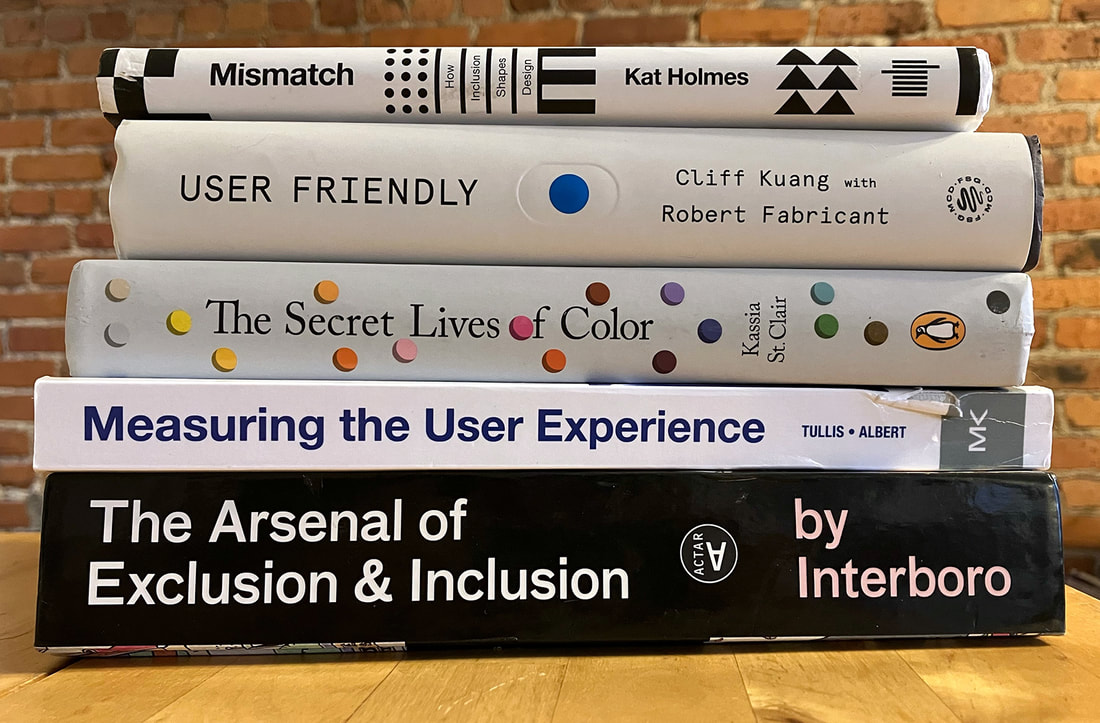Kelli Mijares shares top 5 booksUXRS content strategist shares some of her favorite, yet less conventional readsBy Kelli Mijares
Admittedly, my list of books may not fit within our formal understanding of “User Experience Research and Strategy.” However, each of these authors documents critical moments of a “human experience”—from identifying tools and methods that change how we perceive space to examining the social and cultural implications of the materials we use—that are foundational to defining, exploring, and even measuring a “User Experience.” So, my list of 5 favorites… The Secret Lives of Color By Kassia St. Clair I have never read this work cover to cover but let me tell you why. The book is organized into chapters by color, such as "Blue" — "Green" — "Brown" and within each chapter is a series of short essays that examine each color. While I imagine the experience of reading along the rainbow color by color is a lovely one, I often enjoy St. Clair's compilation of colors on the go, rotating it through various touchpoints of my day… my desk, coffee table, car, and nightstand. As I sip a morning coffee or wait for my car's gas tank to fill, I find a new color. In these essays, St. Clair performs a deep dive into the history, science, or art of the specific color within our Western canon. I often pause to reconsider my understanding of the color in my life, and I am struck by the rich survey of social and cultural observations and implications St. Clair captures in her book. A few colors I love:
User Friendly: How the Hidden Rules of Design Are Changing the Way We Live, Work, and Play By Cliff Kuang, Robert Fabricant Some might call this a history of UX in product and interface design of the last century. However, the authors have aptly named it “User Friendly” for the empathy that they evoke by underlining the impact of design decisions on our lives. Kuang describes this work, “this book began with the century-long journey to find the “user” in “user friendly” — the history of how people have come to understand who people are, what they need, what they’ll use. In the early decades of user-centered design, this meant finding the principles that underlay how we expected the world to behave.” To illustrate two facets of the term “User-Friendly” and how various design decisions led to incidents of “machine error,” “pilot error,” and “designer error,” the book explores these facets in two sections:
Measuring the User Experience By Bill Albert, Tom Tullis While I had the privilege of working alongside Bill in the User Experience Center as a research assistant, it was not until a few months later, when I started at a digital design agency, that I realized the gravity of this book. As the first "full-time" researcher, I was tasked with standardizing how we gathered usability scores from participants and shared these with our stakeholders in a way that highlighted our research value and compelled them to want us to conduct more research. Since then, I have continued to reference this book in my day-to-day work:
The Arsenal of Exclusion & Inclusion By Tobias Armborst, Interboro I found this book while still in architecture school, but I have employed its thoughtful approach to understanding the user experience in digital spaces. Just inside the cover, Interboro lays out the significance of this work: "This book is part of our ongoing effort to identify, understand, and critically reflect on some of these forces that condition our professional work as planners and designs of the public realm." It is another book you can open to any page for a concise essay on one topic. Each topic surveys a single design element and its implications within our built environment (replace "built" with "digital" for our UX purposes). This book should probably come with a warning—it profoundly changed my perception of the world around me and made it delightfully challenging to ignore the tools and barriers to access public spaces. To name a few:
Mismatch By Kat Holmes In this work, Holmes brings concepts of exclusion and inclusion to UX and product design. She examines how careless design can prompt exclusion and how, instead, we can employ inclusive design methods to rectify these "mismatches," especially in our digital spaces. Some takeaways:
0 Comments
Your comment will be posted after it is approved.
Leave a Reply. |
UX Research and StrategyWe are here to serve the UX community: keep you in the know, connected to each other and always learning. Archives
February 2024
Categories |


 RSS Feed
RSS Feed
